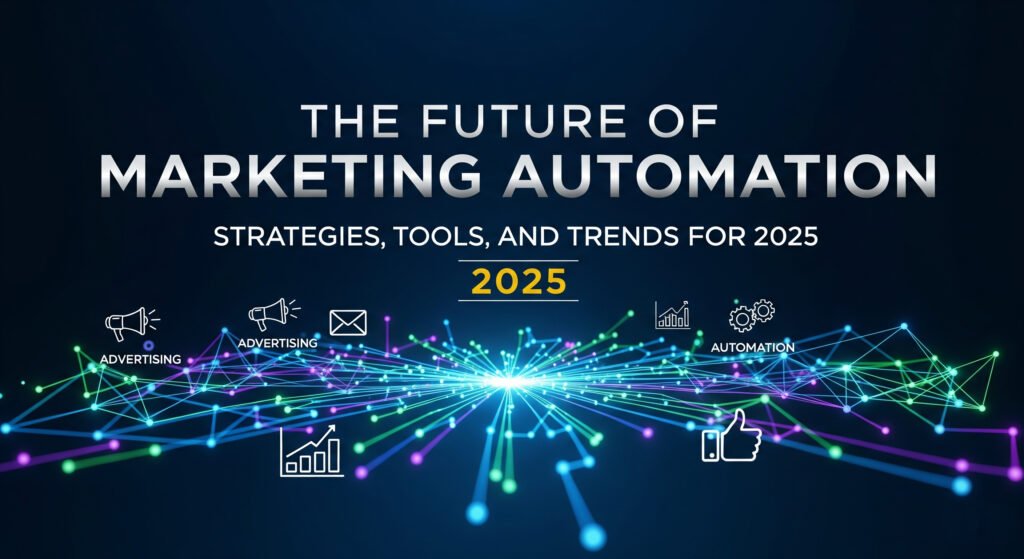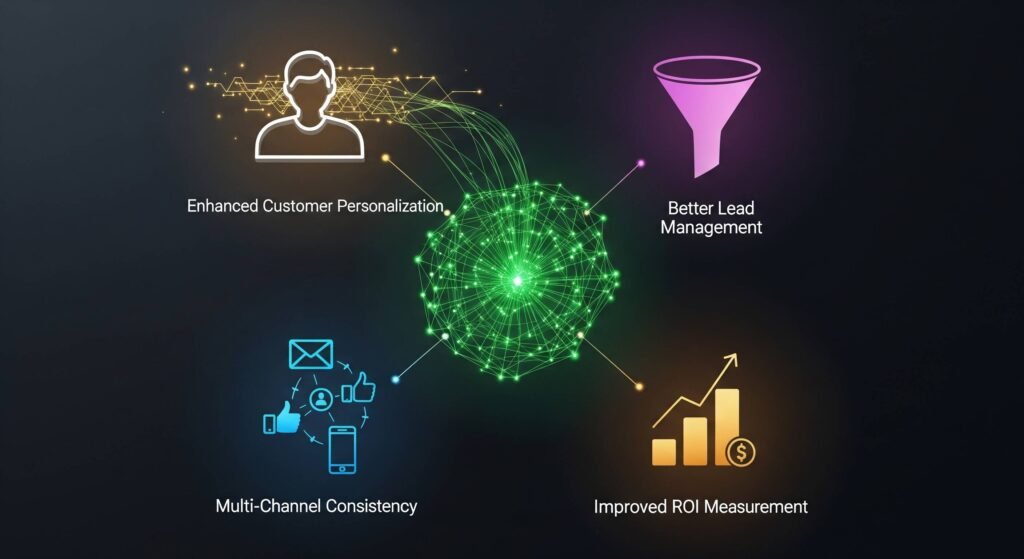- Future of Marketing Automation Strategies 2025 and Trends
- Why Marketing Automation Strategies 2025
- Key Benefits of Marketing AutomationMarketing Automation Strategies 2025
- The Top Marketing Automation Tools in 2025
- Emerging Marketing Automation Trends for 2025
- How Businesses Can Stay Ahead with Marketing Automation
- Real-Life Examples of Marketing Automation Success
- Challenges in Implementing Marketing Automation
- The Future of Marketing Automation Beyond 2025
- Final Thoughts
Future of Marketing Automation Strategies 2025 and Trends
Introduction
The world of marketing is evolving at lightning speed, and technology is at the center of this transformation. In 2025, marketing automation has become a cornerstone for businesses that want to optimize customer engagement, improve efficiency, and drive measurable results. From AI-driven personalization to predictive analytics, today’s marketing tools are not just simplifying tasks—they’re reshaping the way brands connect with their audiences.
This article dives deep into the future of marketing automation: the strategies businesses need to adopt, the tools that are leading the industry, and the trends shaping how brands will compete in the digital marketplace.

Marketing Automation Strategies 2025
Why Marketing Automation Strategies 2025
Marketing automation is no longer a “nice-to-have” feature; it’s a business necessity. With consumers expecting hyper-personalized experiences, manual marketing strategies are outdated and ineffective. Automation helps marketers:
- Save time on repetitive tasks like email campaigns and social scheduling.
- Improve conversion rates through data-driven targeting.
- Scale operations without requiring large teams.
- Deliver consistent customer journeys across multiple platforms.
For businesses in 2025, adopting automation means staying competitive. Ignoring it means losing market share.

Marketing Automation Strategies 2025
Key Benefits of Marketing AutomationMarketing Automation Strategies 2025
1. Enhanced Customer Personalization
AI-powered automation tools analyze browsing behavior, purchase history, and demographics to deliver personalized content. This personalization increases engagement and fosters stronger brand loyalty.
2. Better Lead Management
Automation tools nurture leads with targeted campaigns, ensuring that sales teams only interact with qualified prospects. This improves sales productivity and reduces wasted effort.
3. Multi-Channel Consistency
From social media to email to SMS, marketing automation ensures consistent messaging across all customer touchpoints.
4. Improved ROI Measurement
Advanced analytics give businesses real-time insights into campaign performance, enabling quick optimization and higher return on investment (ROI).
Marketing Automation Strategies 2025
The Top Marketing Automation Tools in 2025

Marketing automation tools are becoming smarter and more integrated. Below are some leading platforms businesses rely on in 2025:
- HubSpot Marketing Hub – Best for all-in-one inbound marketing.
- Marketo Engage (Adobe) – Ideal for enterprise-level lead management.
- ActiveCampaign – Perfect for small to medium-sized businesses with CRM + automation.
- Klaviyo – Specializing in e-commerce automation.
- Salesforce Marketing Cloud – Known for AI-driven personalization.
- Mailchimp – Affordable and effective for startups.
Each tool offers unique features, but the common denominator is AI integration, which makes automation smarter and more adaptive.
Marketing Automation Strategies 2025
Emerging Marketing Automation Trends for 2025
1. AI-Powered Predictive Analytics
AI is enabling businesses to predict customer behavior before it happens. From forecasting churn rates to predicting buying patterns, predictive analytics is transforming targeting strategies.
2. Voice Search and Automation
With voice assistants like Alexa and Google Assistant becoming mainstream, automation platforms are optimizing campaigns for voice-driven queries.
3. Hyper-Personalized Customer Journeys
Instead of segmenting customers broadly, automation platforms in 2025 deliver individualized experiences based on real-time data.
4. Conversational AI and Chatbots
Chatbots are no longer robotic—they now use natural language processing (NLP) to handle complex customer queries and personalize responses.
5. Data Privacy and Compliance Automation
As data privacy laws become stricter (GDPR, CCPA, and beyond), automation platforms are integrating compliance features to protect businesses and customers alike.
Marketing Automation Strategies 2025
How Businesses Can Stay Ahead with Marketing Automation
- Invest in the Right Tools – Choose platforms that align with your business goals.
- Focus on Customer-Centric Strategies – Always prioritize delivering value to the customer.
- Leverage AI and Machine Learning – Automate not just tasks but also insights.
- Integrate Across Teams – Marketing, sales, and customer support should use unified data.
- Stay Updated with Trends – Businesses must constantly evolve to keep up with emerging technologies.
Real-Life Examples of Marketing Automation Success
- Amazon uses AI-driven recommendation engines to suggest products tailored to each shopper, boosting conversions significantly.
- Spotify delivers personalized playlists and marketing emails based on user behavior, keeping engagement rates high.
- Nike leverages automation for personalized SMS promotions and targeted email campaigns that increase brand loyalty.
These case studies prove how automation creates measurable results.
Marketing Automation Strategies 2025
Challenges in Implementing Marketing Automation
While the benefits are undeniable, businesses face several challenges in adopting automation:
- High setup costs for advanced platforms.
- Data integration issues across multiple systems.
- Skill gaps within teams to manage automation effectively.
- Risk of over-automation that makes interactions feel less human.
The solution lies in balancing automation with genuine human touch.
Marketing Automation Strategies 2025
The Future of Marketing Automation Beyond 2025
Looking ahead, marketing automation will become:
- More predictive – anticipating customer needs before they arise.
- More immersive – powered by AR/VR customer experiences.
- More ethical – ensuring data usage transparency.
- More autonomous – self-optimizing campaigns requiring minimal human intervention.
Businesses that adapt early will secure a competitive edge in the digital-first economy.
Final Thoughts
Marketing automation in 2025 is more than a tool—it’s a growth engine. Businesses that embrace AI, predictive analytics, and personalized engagement will not just survive but thrive in an increasingly competitive digital marketplace.
The future belongs to marketers who leverage technology while maintaining human empathy. Those who fail to adopt these tools risk falling behind in customer experience, efficiency, and profitability.
If you want your business to stay ahead, now is the time to embrace marketing automation strategies and build future-ready systems.
Check out our latest post: 👇
The Power of AI Driven Social Listening: Turning Customer Emotion into Brand Growth in 2025
AI Chatbots in Marketing: Boosting Customer Engagement in 2025
Introduction to AI Chatbots in Marketing AI chatbots in marketing Marketing in 2025 looks very…
Generative Engine Optimization (GEO): The Future of SEO in 2025
Introduction Generative Engine Optimization (GEO): The Future of SEO in 2025 Generative Engine Optimization The…
AI-Powered CRM Software for Modern Businesses: The Future of Customer Relationship Management
AI-Powered CRM Software for Modern Businesses: The Future of Customer Relationship Management Introduction In today’s…
Maximizing ROI with AI Powered Marketing Automation: Real-World Insights & Future Outlook
Introduction AI Powered Marketing Automation AI Powered Marketing Automation In 2025, marketing automation isn’t just…
How Marketing Automation Streamlines Customer Onboarding in 2025
Introduction Marketing Automation Streamlines Customer Onboarding First impressions matter in business. When a customer signs…
The Future of AI Powered Email Marketing: Strategies for 2025
Introduction AI powered email marketing Email marketing remains one of the most powerful channels for…


Pingback: Unlock the Power of Chatbots in Modern Marketing Automation